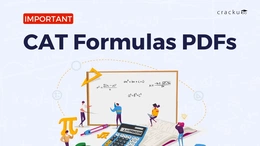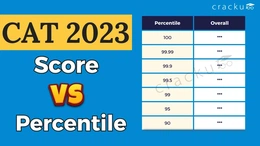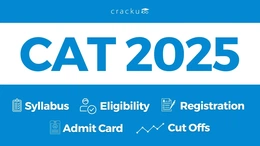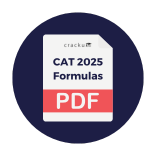How to Prepare for CAT Quant 2025?
Preparing for the Quantitative Aptitude section of the CAT is a crucial step for aspirants seeking admission into prestigious MBA Colleges. CAT Quant demands a solid understanding of mathematical concepts, sharp problem-solving skills, and effective time management. With its challenging questions spanning various topics, mastering this section requires a structured approach, consistent practice, and strategic planning. In this article, you will learn how to effectively prepare for the quantitative aptitude section of CAT Exam Syllabus.
CAT Exam Pattern 2025: Quantitative Aptitude
The following table represents the Quants exam pattern for CAT 2025:
| Section | Details |
| Total Questions for QA | 22 |
| Total Time Allotted | 40 minutes |
| Multiple-Choice Questions | 14 |
| Type in the Answer (TITA) | 8 |
| Marking Scheme | +3 for a right answer -1 for a wrong answer No negative marking for TITA |
CAT 2025 Syllabus: Quantitiative Aptitude
CAT quant syllabus can be divided into the following categories: Arithmetic, Algebra, Number System, Geometry and Mensuration, and Modern Math. Following is the breakup of these topics.
| Arithmetic | Algebra | Number System | Geometry & Mensuration | Modern Math |
| Ratios and proportions | Inequalities | Number Systems | Lines, angles, and triangles | Permutation and Combination |
| Averages | Quadratic equations | Factors | Circles | Probability |
| Allegations | Linear equations | Properties of Numbers | Quadrilaterals | Set Theory |
| Percentages | Logarithm | Type and Classification | Square and rectangles | |
| Profit-loss | Functions and Graphs | Of Numbers | Polygons | |
| Simple & Compound Interest | Maxima Minima | Divisibility Rules | Cylinder, cones, and spheres | |
| Time and work | HCF and LCM | Cubes and cuboids | ||
| Time speed distance | Cyclicity and Base | Rhombus | ||
| Theorem | Trapezium | |||
| Remainders and | Parallelogram | |||
| Remainder Theorems | 3D figures | |||
| Binomial Theorem | Pythagoras Theorem | |||
| The highest power of a number in a factorial | Base Angle Theorem | |||
Series and Progressions | Longest Side Theorem | |||
| Trigonometry |
Important Topics for CAT Quantitative Aptitude
Arithmetic
Arithmetic is an important topic for Quant preparation as we always get 7-8 questions from this topic. It includes Percentages, Profit and Loss, SI & CI, Ratios, Mixtures, Averages, Speed, Time, Distance, Races, Pipes Cisterns and time work. It’s the most important section as it also serves as a foundation for other topics and sections as it aligns well with Data Interpretation, calculations in Algebra, and other topics.
Algebra
CAT Algebra is the next key area after Arithmetic. It requires familiarity with variables like x and y. Topics include Linear and quadratic Equations, Inequalities, Functions, Progressions, and Algebraic Expressions to Polynomials. Though enjoyable, students often struggle with where to begin. Make sure to understand the basics and diligently go through all the past year questions to get the gist of what kind of questions get asked in Algebra.
Number System
Number Systems in CAT comprises 2-3 questions and covers various topics like Factors and Multiples, HCF and LCM, Factorials, Base Systems, Remainders, and more. It's essential to grasp the basics of Number theory, such as Factors and Multiples. Understanding the rules and practicing ample questions is key.
Geometry and Mensuration
Geometry along with Trigonometry, Mensuration, and Coordinate Geometry comprise 6-8 CAT questions. Understanding basic concepts and theorems is crucial. Progress from 2D to 3D Geometry. Memorize formulas and consider symmetry. CAT previous papers help in Mensuration preparation. Knowing theorems expedites problem-solving.
Modern Math
Topics included in Modern Math are permutation and combination, probability, and set theory. Though the questions asked from this section generally range from 0-2, this topic is important for the OMET exam.
Preparation Tips for CAT Quantitative Aptitude
Preparing for the Quantitative Aptitude section requires a structured approach and consistent practice. Here are some tips to help you prepare effectively:
Understand the Exam Pattern: Familiarize yourself with the CAT exam pattern, including the number of questions in the Quantitative Aptitude section, the marking scheme, and the types of questions asked.
Develop Strong Basics: Ensure that you have a clear understanding of fundamental mathematical concepts such as arithmetic, algebra, geometry, number theory, and trigonometry. Strengthen your basics before moving on to advanced topics.
Practice Most Repeated Questions: There are a set of topics and questions that get repeated in the CAT exam every year. Make sure to practice them diligently to tackle them in exams easily.
Time Management: CAT is a time-bound exam, so it's crucial to manage your time effectively. Practice solving questions within the allotted time to improve your speed and accuracy.
Solve Previous Year Papers: Solve previous years' CAT question papers to understand the exam pattern, and types of questions asked, and to gauge your preparation level. Analyze your mistakes and work on improving weak areas.
Mock Tests: Take regular CAT mock tests to simulate the actual exam environment and assess your preparation. Analyze your performance after each mock test to identify strengths and weaknesses.
Focus on Shortcut Techniques: Learn shortcut techniques and tricks to solve problems quickly and efficiently. This can help you save time during the exam.
While the QA may seem daunting to many non-engineering aspirants, consistent practice, dedication, and perseverance are key to succeeding in the CAT Quantitative Aptitude section. Good luck with your preparation!


















![Top CAT Geometry Cricles Questions [Download PDF] Top CAT Geometry Cricles Questions [Download PDF]](/media/cache/37/35/373563e7d0820dbbf9f140c7f5878cc0.webp)



![Top 10 - CAT Geometry Triangles Questions [Download PDF] Top 10 - CAT Geometry Triangles Questions [Download PDF]](/media/cache/95/e1/95e12a34d491e2927874fa1244dc3c71.webp)
![Top CAT Quant Quadratic Equations Questions [Download PDF] Top CAT Quant Quadratic Equations Questions [Download PDF]](/media/cache/c2/05/c205c0abdf778ffd7663c253d9b95a8a.webp)



![Top CAT Geometry Triangles Questions [PDF] Top CAT Geometry Triangles Questions [PDF]](/media/cache/2d/40/2d40909ccde09df6707398e3678e445f.webp)

![Top CAT Geometry Quadrilateral Questions [Download PDF] Top CAT Geometry Quadrilateral Questions [Download PDF]](/media/cache/40/f1/40f1b4335dd86db76388b2e81193758f.webp)














